Do you want to add the 9th chord to your guitar playing?
The 9th chords can add color to your music and develop you as a player. To incorporate them into your playing routine, it is also essential to know a bit of music theory behind their formation and the alteration possibilities.
In this article, we will cover all the types of the 9th chords – the major, minor, and the dominant 9ths. This is followed by the b9, #9, b5, and #5 alterations and how to play them on your guitar fretboard.
Read the complete article to know all the important stuff about the 9th chords on the guitar!
How to build a 9th Chord?
A 9th chord is a member of the extended chord family, built by extending the corresponding seventh chord by another interval of a third. As you undoubtedly know, extended chords have notes spanning more than an octave from the root note, even in their root position. So they are the extensions of the basic triads and the seventh chords and feature a tertian harmony.
All the chords right from the 7th chords onwards are considered dissonant chords in Western music, as any one of their inner or outer intervals falls in the dissonant category. We can further increase the dissonance by extending and altering the basic chords. Altered chords are extended chords with one of their notes chromatically altered by raising or lowering it by a semitone.
You can combine two simple triads or one triad and a seventh chord to get the 9th chord, in forms known as polychords.
Types, Notes & Notations of the 9th Chords
The ninth chords have only three chord qualities – Major, Minor, and Dominant. The core of these chords is up to the seventh note, and the tones up to 7th are often called chord tones. All the other types of 9th chords are the alterations on these basic chords. The ninth note in all these three basic sonorities is at the major ninth interval from the root.
Let us go through the different types of the most common ninth chords briefly, including the important altered ones, and understand their structure, notes, and notations.
Major 9th Chord
Major ninth chords are formed by stacking a minor third interval over the Major Seventh chord. The Maj7 chords have a major 3rd interval stacked over a major triad formed from the scale degree 1 and 4 in a major scale.
They have a chord formula [1 3 5 7 9] and are denoted as CMaj9 or C Major 9. In the key of C, the CMaj9 chord is [C E G B D]. These are very cool-sounding chords with a dreamy texture.
Minor 9th Chord
Minor Ninth chords are built by stacking a major third interval over the basic minor seventh chords. The minor seventh chords have a minor 3rd placed over the minor triad formed from the scale degrees 2, 3, and 6 in a major scale.
Their chord formula is [1 b3 5 b7 9] with the basic representation C minor 9 or Cm9. The notes of the Cm9 chord are [C, Eb, G, Bb, D].
The chord has a bluesy sound that goes very well with the dom9 chords, which we will discuss next.
Dominant 9th Chord
The dominant ninth chords find maximum use out of all the different types of ninth chords. They have an interval of a major 3rd placed over a dominant seventh chord, known as the dom7 chords. The dom7 chords are built from the scale degree 5 of the major diatonic scale and have a dominant function.
The chord formula for a dom9 chord is [1 3 5 b7 9] with the basic representation C dominant 9 or C9. It is denoted as the V9 chord in the Roman numeral notation. The notes of the C9 chord are [C, E, G, Bb, D]. As you can see, the only difference with the Major 9th chords is the flat seventh.
The chord is often referred to as the funk chord and finds its major use in funk and jazz music. You can easily substitute a dom9 chord for a dom7 chord, and it provides a funkier and jazzy sound.
The root, 3rd, 7th, and 9th are the most important factors of a V9 chord, and the 5th can be omitted if you want. The resolution of the 7th and the 9th note in the chord happens downwards to the 3rd and the 5th note of the tonic triad.
Some of the popular songs using the dom9 chords are:
- Hotel California (Eagles) uses E9.
- If I Fell (Beatles) uses D9.
- My Life (Billy Joel) uses a D9 chord.
- Eye in the Sky (Alan Parsons Project) uses an E9 chord.
Add9 Chord
Add9 or the “Added Ninth” chord falls in the added tone chords family. The added tone chords are formed by leaving out a seventh of the chord and adding other tones. What you are basically doing is adding a tone to the basic triad.
The add9 chord is formed by adding the major 9th to the major triads. The add9 chords have the notes [1 3 5 9]. For example, the Cadd9 chord has the tones [C, E, G, D]. Most beginners learn Cadd9 as their first added tone chord on the guitar.
Add9 chords are similar to Sus2 with an added 3rd and the Major 2nd being an octave up.
The add9 chords are very common and are used in pop and rock music to add variety and spice to the triads.
The 6/9 chord
The Major 6/9 chord has a 6th substituted for the 7th note in the Major 9th chord. You can also consider that C6add9 chords have the 9th tone added to the 6th Major chord. Hence the Major 6/9 chord has the formula {1 3 5 6 9].
The C Major 6/9 chord has notes [C E G A D]. Note that the “A” note is at the major 6th interval. It sounds more like a 6th chord than a ninth chord. The 6/9 chords are less visible in popular music but are commonly played in jazz. They may be used for American or even for country music.
Songs using the major 6/9 chords are:
- Jealous Guy (John Lennon) – F6/9 in the second chord of the chorus.
- Grandpa (Judds) – A6/9
You can similarly have the Cm6/9 chords with the tones [C Eb G A D]. Note that the chord has an added 9th tone to the 6th minor chord. Some of the popular songs with minor 6/9 chords are:
- Every Breath you Take (Police). The song has Em6/9 chords.
- Eye of the Tiger (Survivor). (C minor).
- Tonight (Def Leppard). (A minor).
Altered 9th chords
So far, we have dealt with the basic sonorities and the added tone chords. In all these chords, the 9th note was at the major 9th interval from the root. Now let us review some common altered chords.
As stated earlier, the altered chords are formed by lowering or raising the 9th note of the extended chords by a half step chromatically. This means the 9th note will not be in the key of the corresponding scale.
Major 9th Altered chords
By altering the Major 9th chords, you get:
- B9 variation: This chord is called Major7b9 or Major7(b9). It has a flat ninth note which is the same as the minor second note, an octave higher. The nomenclature of these chords means that it is a major 7th chord with a b9 extension. The notes of CMajor7(b9) are C, E, G, B, and Db.
- #9 variation: The chord is denoted as Maj7#9 or Maj7(#9), and the notes of CMaj7(#9) are C, E, G, B, and D#.
Minor 9th Altered chords
By altering the Minor 9th chords, you get:
- B9 variation: The altered ninth minor chord is denoted by m7b9. The notes of Cm7b9 are C, Eb, G, Bb, and Db.
Dominant 9th Altered chords
By altering the Dominant 9th chords, you get:
- B9 variation: The resulting chord is called 7b9, and the notes of C7b9 are C, E, G, Bb, and Db. The chord effectively heightens the drama and the sense of threat. Many players use this chord as the dominant chord in minor keys while using the dom7 chords in the V – I chord progression in the major keys.
- #9 variation: The chord is designated as 7#9, and the notes of C7#9 are C, E, G, Bb, and Eb. It is one of the most popular chords in the altered type and is known as Hendrix’s chord. It is used in funk, rock, blues, and jazz music. In the song Purple Haze by Jimi Hendrix, you can see E7#9 in action. In the song “All Blues” by Miles Davis, D7#9 and Eb7#9 have been used.
Dominant 9b5 and 9#5 Chord
In these chords, we alter the 5th note instead of the 9th in the dom9 chords.
- B5 variation: The resulting chord is called 9b5, and the notes of C9b5 are C, E, Gb, Bb, and D.
- #5 variation: The chord is designated as 9#5, and the notes of C9#5 are C, E, G#, Bb, and D.
Inversions of the 9th Chords
As the 9th chords have five notes in a complete chord. They have four inversions in addition to the root position chords. In guitar playing, you have to skip some of these notes as you do in the other extended chords.
The notes of the D9 chord are [D F# A C E]. Its inversions are:
- First inversion D9/F# with notes [F# A C E D].
- Second inversion D9/A with notes [A C E D F#].
- Third inversion D9/C with notes [C E D F# A].
- Fourth inversion D9/E with notes [E D F# A C].
9th Chords on Guitar – Guitar Chord Charts
In this section, you can learn how to play the different types of the ninth chord on your guitar fretboard.
Major Ninth Chord Chart
You can see the different voicings of the Maj 9 chords in the chord diagrams below. Wherever possible, we have tried to use open voicing. You can also see the moveable shape, which can be used to play all the Maj 9 chords.
Open Shapes
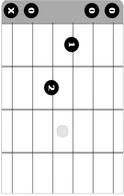
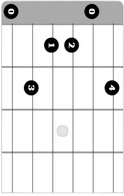
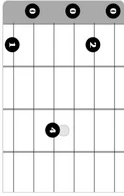
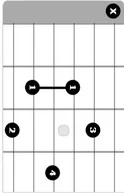
Moveable Shape
Each chord is marked with a different color, and the root note is named to identify the chord with a color.

Minor Ninth Chord Chart
Open Shapes
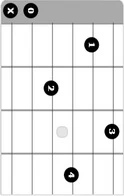
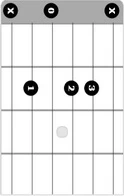
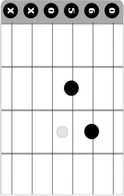
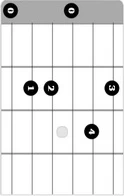
Movable Shape 1 – Root at 4th String

Movable Shape 2 – Root At 6th String

Dominant Ninth Chord Chart
Open Shape
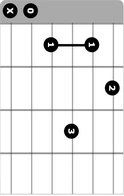
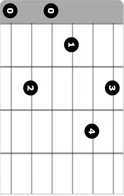
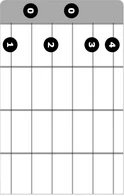
Moveable Shape – Root at the 5th String

Conclusion
We hope that we have been able to provide you with the required information about the 9th chords that you were looking for. If you need any additional information, so write to us in the comments section below. We will try to respond in the shortest possible time.
